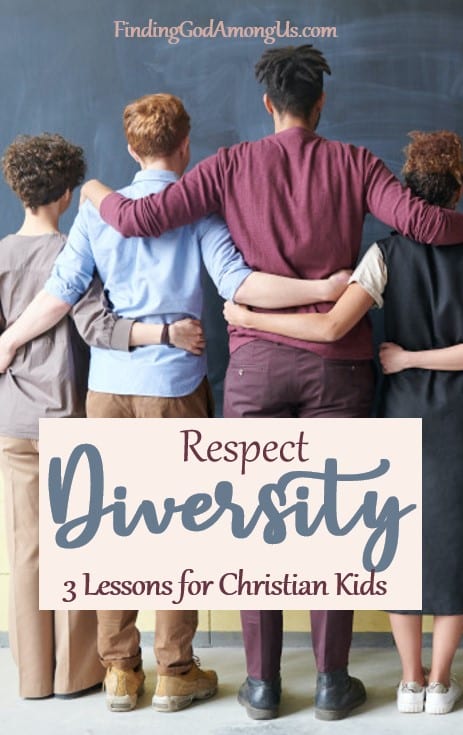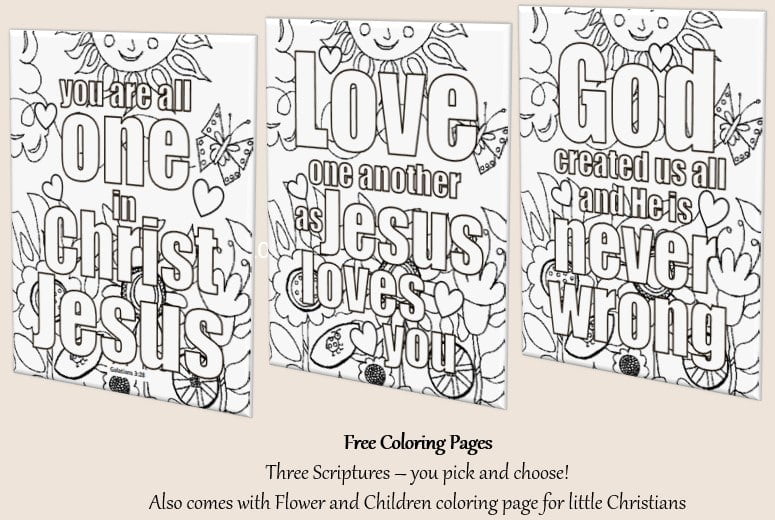Are you looking for Bible lessons for kids to teach them to respect diversity? Teaching children about racial diversity is a timely topic but also a timeless one. Because no two people are alike, children will always need to learn diversity, whether it be for religious, racial, cultural, or physical ability differences. When we use the Bible as the foundation and tackle diversity at a simplistic level, this complex topic can be easy for children to grasp.

Bible verses about equality
These lessons about respecting diversity are based on three key bible verses. All are NIV versions.
Even so the body is not made up of one part but of many. 1 Corinthians 12:14
There is neither Jew nor Gentile, neither slave nor free, nor is there male and female, for you are all one in Christ Jesus. Galatians 3:28
Love one another. As I have loved you, so you must love one another. John 13:34
3 LESSONS – Respect Diversity for Kids:
We’re Not All the Same
Even so the body is not made up of one part but of many. 1 Corinthians 12:14
Just as a body, though one, has many parts, but all its many parts form one body, so it is with Christ. (1 Corinthians 12:12) All people are part of the body of Christ, not just the ones who look like we do. The hands are different than the legs, but they’re both necessary, valuable, and cherished. God created us in His image as equals – even though we’re different.
We can use flowers as an example of an ‘equality’ definition for kids. Children understand there are many different types. Roses, daffodils, tulips, geraniums, and orchids are just a few.
So which one is best? Or which ones are better than other ones?
Some adults might say that dandelion flowers are the worst when they grow in the yard, but what is more beautiful than an entire field glowing with brilliant yellow dandelions? A stunning red rose is fancy and may smell divine. Does that make it “better” than a dandelion flower? What about a tulip that gives the first burst of color after a dreary and cold winter? What a sight for sore eyes! But, is the tulip better than the rose or the dandelion?
No, flowers are similar but different. None are “better” than the others. It’s the same with people. We’re all created in God’s image, even though we have differences.
Now we’ve established that we’re all different, so next, we need to create tolerance for those differences.
But how?
Celebrate Differences
In order to teach tolerance, we need to celebrate the differences.
There is neither Jew nor Gentile, neither slave nor free, nor is there male and female, for you are all one in Christ Jesus. Galatians 3:28
When we teach children about diversity, the focus should be on celebrating the differences, not ignoring them. Are all the flowers the same? Any child understands that flowers come in different sizes, shapes, and colors. We don’t ask them to pretend they’re all the same. We don’t say, “I don’t see color” when we see a dandelion. Of course, we see yellow. Instead of ignoring differences in nature, we appreciate the differences in all the flowers. Why wouldn’t we give people the same consideration? Saying we don’t see color when it comes to people is to ignore who they are, their heritage, culture, and lifestyle differences. Ignoring differences isn’t tolerance.
When we celebrate our differences as humans, we care about each other and communicate with each other. In the world of flowers, the conversations might start something like these: The dandelion might say to the rose, “Do your thorns poke you?” Or the tulip might say to the dandelion, “How do you make yourself turn into a ball of fluff?”
When humans celebrate our differences and have tolerance for others, we have open, empathetic, and peaceful dialogue without pretending that we have no differences. It’s our job as adults to steer and nurture these conversations as our children grow in their understanding.
Love One Another
Love one another. As I have loved you, so you must love one another. John 13:34
Humans aren’t perfect. Jesus knew that sometimes we would fail and find it hard to appreciate our differences or recognize we’re all created equally.
He gave us a command for these times. Jesus said Love one another. Those three little words are really all we need to understand about diversity.
He didn’t say to love the ones who look like us, who act like us, or who speak as we do. He simply said to love. Loving is a choice. A child instinctively knows what loving someone looks like. It’s our job to model the loving behavior our children need to see in order for them to respect diversity. Otherwise, the world will teach them that diversity is bad.
Teaching our children, grandchildren, and students racial unity is critical to a Christian foundation. Certainly giving children a good example of racial tolerance and other diverse perspectives at home sets the best foundation for their future. Children are more apt to do what we do than do what we say.
Are we securing a solid Christian foundation?
Respect Diversity for Kids: Suggested Activities
Ages 3-7. Color three flowers (differently). Color three people (differently). Which one is the best flower and which one is the best person? Answer key – none are the best! All are different and equal and loved by God. I’ve already designed a free coloring page for you!
Ages 7-12. Potential journal exercise: Have I bullied someone for being different than I am? If so, why? Have I witnessed someone being bullied for being different? Did I step up to support them? Why or why not? Do I feel negative about someone because they don’t look like me? List two (kind) ways that a classmate and I are different and three ways we are similar – make sure they list more similarities than differences.
Ages 13+. Potential questions for journaling: In what ways have I failed to appreciate people or cultures that are different from mine? What can I do in my life or in my heart to be more accepting of others? What is something I’d like to know about a different culture? Then go find out – preferably by asking a classmate, or use online search if necessary.
Free Coloring Pages:
Our free coloring pages include the Bible verses used in this article (or paraphrased) as well as one that includes flowers and people for the young children’s exercise, as described in the suggested activities above. Use one (or all) of the free coloring pages to add an activity to your diversity lesson for children. They’re suitable for kids of all ages. Instant download – no signup required!

The background for the coloring pages came from Free Coloring Pages. Be sure to check them out!
Thank you to fauxels from Pexels for our cover image diversity photo!
How are you teaching children diversity? Let me know in the comments!